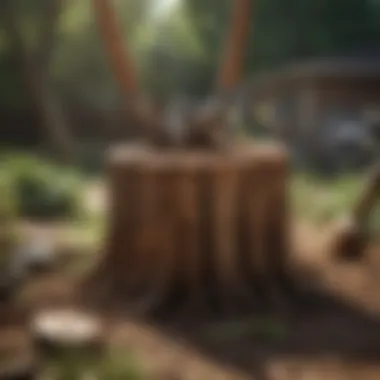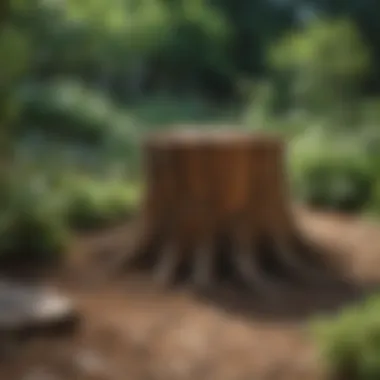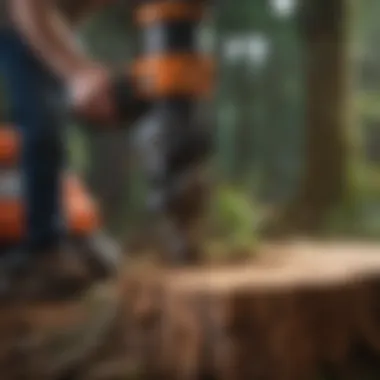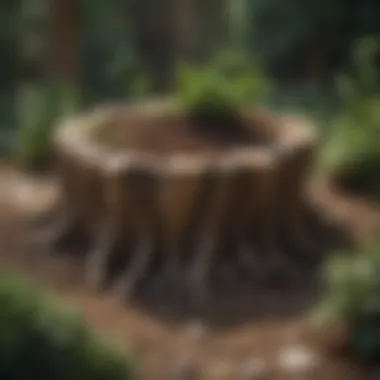Expert Guide on Stump and Root Removal Techniques


Intro
Removing stumps and roots from your property is a task that, while often overlooked, is crucial for many homeowners and gardening enthusiasts. It may seem like a straightforward job, but the intricacies involved vary significantly depending on the size of the stump, the type of tree, and the conditions of your garden. Understanding the reasons for stump removal, the methods available, and the essential considerations when undertaking this task is vital for effective planning and execution.
Stumps can take up valuable space in your garden, hinder landscaping efforts, and pose potential hazards for children and pets. Additionally, they may harbor pests and diseases, further complicating the growth of surrounding plants. Therefore, tackling stumps and roots is not just about aesthetics; it is about ensuring a safer and more functional outdoor environment.
In this guide, we will explore various methods for removing stumps and roots, ranging from manual techniques to mechanical solutions. Each method has its advantages and limitations, which we will detail to help you choose the best approach for your specific situation. Moreover, this article will cover safety precautions, the impact on the environment, and post-removal landscape management, providing you with a comprehensive understanding of stump and root removal.
Understanding Stumps and Roots
Understanding stumps and roots is essential for any homeowner or gardening enthusiast contemplating the removal of problematic vegetation. Tree stumps and their associated root systems can become more than mere eyesores; they can impede landscaping projects, cause potential hazards, and attract unwanted pests. Recognizing the complexity of what lies beneath the soil offers a clearer perspective on how best to approach their removal.
Types of Tree Stumps
Stumps can be categorized based on various factors. Common types include:
- Decayed Stumps: These are remnants of trees that have died and begun to decompose. They are often softer and easier to remove.
- Live Stumps: These stumps still have active root systems connected to living trees, making them challenging and risky to remove without proper techniques.
- Hollow Stumps: These stumps have rotted internally but may still stand robustly outwardly. Removal can vary based on structural integrity.
- Cut Stumps: These stumps have been sawed down, often leaving a flat surface at ground level.
Understanding these types aids in selecting suitable removal methods, knowing the risks involved, and planning for what comes next in the landscape.
Life Cycle of Roots
Roots play a crucial role in a tree's life cycle. Initially, they establish themselves shortly after germination, seeking nutrients and stability as the tree grows. As the tree matures, roots spread out, often reaching far beyond the tree’s canopy. The health of root systems is vital for:
- Nutrient Absorption: Roots take in essential minerals and water from the soil, supporting the tree's overall health.
- Stability: A robust root system anchors the tree, allowing it to withstand strong winds and adverse weather conditions.
- Communication and Support: Roots can connect with other trees and plants, sharing nutrients and supporting ecosystem dynamics.
However, when the tree dies, roots begin to decay, and their life cycle transitions. Understanding this process is crucial when planning for stump removal. Knowing whether roots are still alive or decomposing will influence the removal strategy.
Importance of Root Systems
Root systems serve functions beyond mere stability. They:
- Enhance Soil Fertility: Roots contribute organic material to the soil as they die and decompose, improving soil health.
- Support Ecosystem Biodiversity: Healthy roots create habitat for various organisms, promoting a thriving ecosystem.
- Provide Water Regulation: Roots help retain moisture in the soil, which can be critical in drought-prone areas.
Thus, engaging thoughtfully with stump and root removal is not just about aesthetics but also involves understanding these ecological functions.
"Removing a stump is not merely a physical task, but a decision that impacts the ecosystem. Thoughtful planning can enhance garden beauty and promote biodiversity."
Comprehending the factors surrounding stumps and roots enables homeowners to make informed decisions. This knowledge can help avoid future complications and facilitate healthier landscapes.
Reasons for Stump and Root Removal
Understanding the reasons for removing stumps and roots is crucial for homeowners. Undeniably, decaying stumps do not only pose aesthetic issues, but they also impact many critical aspects of a garden. The removal process is more than just clearing space; it plays a role in maintaining the integrity of your landscape. With this knowledge, one can make informed decisions regarding their yard care.
Improving Aesthetic Appeal
A front or back yard dominated by stumps can significantly detract from the overall appearance of a property. Removing these unsightly remnants of trees can restore beauty and symmetry to the garden. A clean and well-maintained landscape can impress neighbors and visitors and can even enhance the home's value. Those looking to host outdoor gatherings will benefit from a visually appealing space.
Key aspects include:
- Enhanced Visual Space: A stump-free area allows more freedom in layout and design.
- Potential Enhancements: With stumps gone, you can incorporate new plants and landscaping features, creating a fresher visual appeal.
- Increased Usable Space: The removal opens up areas that can be utilized for additional activities or landscaping elements.
Preventing Pest Infestation
Old stumps and roots can act as hosts for a variety of pests and diseases. These lingering remains, especially when decaying, attract insects that can extend their reach to healthier plants. This can lead to infestations that impact the entire garden.
Considerations include:
- Termite Population: Stumps can harbor termites that compromise nearby structures.
- Fungal Growth: Decomposing wood promotes fungal growth which can spread to healthy plants.
- Rodents and Other Pests: They find refuge in stumps, leading to possible invasions in gardens or homes.
Enhancing Landscape Functionality
The functionality of a landscape can be hindered by the presence of stumps and roots. Whether it is for gardening, recreational activities, or simple convenience, an unobstructed area allows for better usage of one’s outdoor space. Removing stumps not only aids in creating a designated area for lawn maintenance but also clears pathways.
Benefits of increased functionality include:


- Easier Maintenance: Lawnmowers and other equipment can operate effectively without obstacles.
- Enhanced Planting Options: Clearing stumps creates opportunities for new planting without competition for nutrients and space.
- Improved Accessibility: Spaces free from stumps provide easy access for people and pets.
"Removing stumps is not just about aesthetics; it is essential for the health of the garden and home."
Methods of Stump and Root Removal
Removing stumps and roots is crucial for several reasons. First, it enhances the safety and aesthetics of your outdoor space. Second, it allows for improved landscape functionality. Finally, understanding various stump and root removal methods will help you choose the most effective technique based on your specific situation, ensuring a cleaner and more usable area.
Manual Removal Techniques
Manual techniques involve using hand tools to physically extract the stump and roots from the ground. This method is often preferred for smaller stumps, especially in residential yards where larger machinery cannot operate.
Hand Tools Required
The essential hand tools for manual removal include a shovel, axe, and pry bar. These tools are fundamental because they provide a straightforward approach to stump removal without the need for machinery. The key characteristic of hand tools is their accessibility and ease of use.
Advantages and Disadvantages:
- Advantages:
- Disadvantages:
- Cost-effective; generally requires minimal investment.
- Quiet operation; does not disturb neighbors.
- Labor-intensive; can be physically demanding.
- Time-consuming; may take longer than mechanized methods.
Step-by-Step Process
The step-by-step process for manual stump removal generally includes:
- Digging around the stump to expose roots.
- Cutting through the roots with an axe or saw.
- Leveraging the stump with a pry bar or shovel to loosen it.
- Finally, pulling the stump out of the ground.
This method is beneficial as it allows for a clear understanding of the root structure while giving control over the process. However, its unique feature is that it may not be effective for larger stumps, which can require a different approach.
Mechanical Means
Mechanical means refer to using powered machinery for stump and root removal. This is suitable for larger stumps or when time and manpower are limited.
Using a Stump Grinder
A stump grinder is a powerful machine designed specifically for this task. It efficiently grinds the stump below soil level, making it a popular choice for many homeowners.
Advantages and Disadvantages:
- Advantages:
- Disadvantages:
- Fast and efficient; significantly reduces labor time.
- Can handle larger stumps.
- Higher cost; rental or purchase expenses.
- Requires some skill to operate safely.
Excavation Equipment
Excavation equipment, such as backhoes or excavators, can also be used to remove stumps. These machines remove the stump and sizable roots with ease.
Advantages and Disadvantages:
- Advantages:
- Disadvantages:
- Capable of removing large stumps quickly.
- Efficient for large-scale landscaping projects.
- Expensive; the cost of rental can be high.
- Requires space; not ideal for small yards or tight areas.
Chemical Solutions
Chemical solutions can be effective for stump removal, especially when time is not a constraint. These methods involve applying chemicals to decompose wood and roots over time.
Types of Chemicals
Common types of chemicals include potassium nitrate and herbicides. These chemicals speed up the decay process of the stump.


Advantages and Disadvantages:
- Advantages:
- Disadvantages:
- Minimal physical labor required.
- Effective over the long term.
- Takes time; may require weeks or months for complete decay.
- Potentially harmful to the surrounding environment if not used properly.
Application Methods
The application methods involve drilling holes into the stump and applying chemicals directly, which helps accelerate the degradation of the wood.
Advantages and Disadvantages:
- Advantages:
- Disadvantages:
- Can be done easily without special equipment.
- Cost-effective for many homeowners.
- Requires patience; as mentioned, may take a long time for visible results.
- User must follow safety guidelines to avoid hazards.
Burning Techniques
Burning is another method to remove stumps, but it carries various implications for safety and legality.
Safety Precautions
When using fire to remove a stump, safety precautions are paramount. Always check local laws regarding burning and take necessary measures to prevent unintended fires.
Advantages and Disadvantages:
- Advantages:
- Disadvantages:
- Effective for complete removal of stumps.
- Can be completed in a relatively short timeframe.
- High risk; requires constant monitoring of fire.
- Legal restrictions may apply based on location.
Effectiveness
Burning can effectively destroy the stump and roots if done correctly. However, the effectiveness may vary based on the type of wood and moisture content.
Advantages and Disadvantages:
- Advantages:
- Disadvantages:
- After burning, the area can be reseeded or replanted quickly.
- Creates minimal ground disturbance compared to other methods.
- Leaves charred residue, which may require additional cleanup.
- Potential damage to surrounding flora if not managed carefully.
Safety Considerations
When engaging in stump and root removal, safety should always be one of the foremost concerns. The risks associated with handling heavy equipment, sharp tools, and chemical substances are significant. For homeowners and enthusiasts alike, understanding the safety measures is essential to prevent injuries and ensure smooth execution of the process.
Personal Protective Equipment
Using the right personal protective equipment (PPE) is crucial when removing stumps and roots. Depending on the method employed, the following items are recommended:
- Safety goggles: Protects the eyes from flying debris during cutting or grinding.
- Work gloves: Minimizes the risk of cuts and abrasions while handling tools and materials.
- Steel-toed boots: Provides foot protection against falling objects and heavy equipment.
- Hearing protection: Essential, especially when using loud machinery such as stump grinders.
- Dust mask or respirator: Important when working with chemicals or when dust is generated during the removal.
Wearing these items can significantly reduce the likelihood of accidents and injuries.
Identifying Hazards
Awareness of potential hazards is another critical safety consideration. Homeowners should assess their working environment before commencing any stump and root removal project:
- Uneven ground: Be cautious of unstable or slippery surfaces that can lead to falls.
- Utilities underground: Before digging or cutting, it is important to locate any electrical lines or water pipes. Calling local utility companies for marking is advisable.
- Insect nests: Stumps may harbor insects or pests, which can pose health risks.
- Weather conditions: Rain or high winds can create dangerous situations, especially when working with machinery.


By analyzing these hazards, one can take preemptive measures to ensure a safer working environment.
Always prioritize safety over speed. Taking the time to prepare can prevent accidents that might otherwise spoil your gardening efforts.
Environmental Considerations
Environmental considerations play a crucial role when it comes to stump and root removal. These considerations help ensure that the process does not lead to unintended consequences on the surrounding ecosystem. Careful attention to environmental aspects can promote sustainability while maintaining the beauty of outdoor spaces.
Impact on Soil Health
Removing stumps and roots can significantly affect soil health. Roots contribute to soil structure and nutrient dynamics. When taken out, the soil may lose essential nutrients, which can alter its composition negatively. This may result in reduced fertility for future planting. Furthermore, soil erosion may occur without the support of deep-rooted plants, leading to issues of land degradation.
To mitigate these effects, it is important to:
- Assess Soil Quality: Prioritize soil testing before and after removal.
- Replenish Nutrients: Introduce organic matter back into the soil, such as compost or mulch.
- Implement Erosion Control: Use plants or ground cover to protect loose soil areas from erosion.
Wildlife Habitat Disruption
Wildlife habitats are often disturbed during stump and root removal. Many small creatures rely on roots and stumps for shelter and food. Removing them disrupts their ecosystems, displacing wildlife and altering food chains in the area. It is essential to recognize the potential impact on local fauna.
Homeowners should consider:
- Timing of Removal: Perform removals during off-seasons to reduce disruption for nesting birds and other wildlife.
- Habitat Restoration: After removal, enhance the area for wildlife by planting native flora that provides food and shelter.
Regulations and Best Practices
Adhering to regulations and best practices is vital for responsible stump and root removal. Many local jurisdictions have specific laws that guide these actions to protect the environment.
Key practices to consider include:
- Research Local Regulations: Check with local authorities about permits or restrictions.
- Plan Carefully: Create a removal plan that minimizes damage to surrounding areas.
- Consider Professional Help: Engage certified arborists or landscape professionals who follow eco-friendly practices.
Following environmental considerations not only helps in maintaining the balance within an ecosystem but also ensures that landscaping remains a sustainable practice.
Post-Removal Landscape Management
Post-removal landscape management is critical for maintaining a healthy and aesthetically pleasing outdoor space. After the stumps and roots have been removed, the land requires careful attention to ensure it supports new growth and harmonizes with the overall environment. Proper management not only aids in visual appeal but also contributes to soil health and ecosystem balance.
Filling and Leveling
Once the stumps are removed, filling and leveling the area is often necessary. This ensures the landscape appears uniform and accessible. If the area is not leveled properly, it can lead to water pooling, which may create an ideal environment for pests and further plant damage.
Here are some steps to effectively fill and level the area:
- Assess the Area: After stump removal, evaluate the depth of the hole left behind.
- Gather Suitable Fill Material: Topsoil or a mix of topsoil and compost is preferable. This provides nutrients for any future plants.
- Fill the Hole: Add the fill material, but ensure it doesn't sit above the surrounding ground level.
- Level the Surface: Use a rake to spread and level the fill. Ensure a smooth surface to promote the growth of new grass or other plants.
Replanting Strategies
Replanting after stump and root removal can revitalize the garden space. Choosing the right plants is essential for a successful transition. Considerations include soil quality, sunlight, and water availability. Here is a strategy to ensure proper replanting:
- Choosing Plants: Select species that thrive in your local environment. Native plants are usually a safe choice.
- Timing: Early spring or fall is often the best time for planting, allowing roots to establish before extreme temperatures.
- Plant Distribution: Avoid crowding plants; follow spacing recommendations according to the species to allow air and light.
- Watering: Newly planted areas should be watered adequately. This helps them establish strong root systems quickly.
Soil Amendment Recommendations
Soil health plays a significant role in the success of a re-established garden. After stump removal, the soil may be disturbed, lacking nutrients essential for plant growth. Here are some recommendations for soil amendments:
- Organic Matter: Adding compost improves soil structure and fertility, enhancing water retention and drainage.
- pH Balance: Testing soil pH can indentify whether it needs adjustment. Most plants prefer a pH between 6.0 and 7.0.
- Nutrient Solutions: Fish emulsion or other organic fertilizers can provide essential nutrients to the soil.
"Healthy soil is the foundation of a thriving garden, influencing the growth of plants and the overall ecosystem."
In summary, effective post-removal landscape management involves careful filling, leveling, replanting strategies, and soil amendments. These elements work together to restore and enhance your outdoor space, ensuring it thrives well into the future.
Epilogue
The conclusion of this article encapsulates the intricate discussions surrounding stump and root removal. This topic is of high significance, especially for homeowners and gardening enthusiasts looking to maintain or enhance their landscapes. Understanding the various methods for effective removal, whether manual, mechanical, or chemical, is crucial. Each method has its intrinsic benefits and considerations that one must evaluate before execution.
Summary of Key Points
In reviewing the main aspects of stump and root removal, several key points emerge:
- Importance of Removal: Tree stumps and roots can impact both aesthetics and functionality in your outdoor space. Removing them improves visual appeal and prevents potential hazards.
- Methods Available: The variety of techniques available underscores the need for selecting an appropriate approach. Manual methods are labor-intensive but can be effective, while machinery like stump grinders offers efficiency.
- Safety First: Emphasizing safety precautions cannot be overstated. Ensuring the right personal protective equipment and identifying hazards are paramount.
- Environmental Considerations: Understanding the impact of removal on soil and wildlife is critical to making informed decisions, ensuring minimal disruption and adherence to regulations.
- Post-Removal Management: After stump and root removal, landscape management is essential. This includes filling, leveling, and selecting proper replanting strategies, ensuring the restoration of the site.
By considering these points, readers can appreciate the comprehensive nature of the topic. Engaging with the content fosters not only awareness but also the capability to make informed decisions in their landscaping endeavors.



